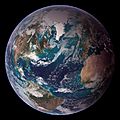Ecological footprint facts for kids
An ecological footprint measures how much people take from nature. The footprint is then compared to the amount of natural resources nature can renew. The ecological footprint takes into account how much farm land, forest area, grazing land and sea area it takes to provide everything people use. More simply, footprint calculations answer the questions: how much nature do we have? And how much do we use?
When analyzing the world as a whole, humanity is using nature about 1.7 times faster than nature renews itself. It is like using 1.7 planet Earths. Since people consume differently around the world, it is also possible to calculate how many planet it would take if everybody around the world consumed like a particular population. For instance, if everybody consumed like the Germans, it would take nearly 3 planet Earths. Expressed in area: The ecological footprint per world citizen is about 2.8 global average hectares per person while there are only 1.6 global hectare of biologically productive land and water per person on Earth. This means that humanity has already overshot global biocapacity by 70% and now lives unsustainably by depleting stocks of "natural capital".
All this data is based on the 2020 assessment from Global Footprint Network, York University, and FoDaFo. It uses 2017 data.
Related pages
Images for kids
-
The natural resources of Earth are finite, and unsustainable given current levels of use.
-
Ecological footprint for different nations compared to their Human Development Index
See also
 In Spanish: Huella ecológica para niños
In Spanish: Huella ecológica para niños





